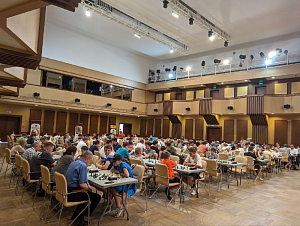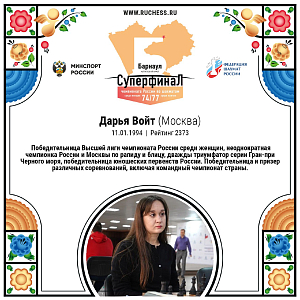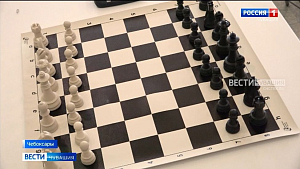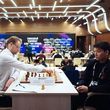Mutual Amnesty
Game two of the Inarkiev – Gelfand match in the review of Vladimir Barsky
The Nazran match has resumed an excellent tradition seen last year: after the game the opponents would Immediately approach the audience to share their impressions. Meanwhile, your correspondent records everything and then rechecks all lines on the computer. Game two was so complex that there has remained a lot to catch up with yet. Anyway, the amount of lines processed by grandmasters during the game commands respect.
Inarkiev – Gelfand
English Opening
1.c4 c5 2.Nf3 Nc6 3.d4 cxd4 4.Nxd4 Nf6 5.Nc3 e6 6.a3
This is Viktor Lvovich Korchnoi’s favorite move.
6…Be7
Ernesto has put this line into his arsenal not long ago and has it tested in a friendly match that took place on Kamchatka: 6...Bc5 7.Nb3 Be7 8.e4 0-0 9.Be2 b6 10.0-0 Bb7 11.f4 d6 12.Be3 a6 13.Qd3 Qc7 14.Rac1 Nb8 15.Nd4 Nbd7 16.b4, and White ended up achieving an edge in that blitz game, Inarkiev – Hou Yifan, Petropavlovsk-Kamchatsky 2016.
7.e4 0-0 8.Nf3 Qa5 9.Bd2 Qh5 10.Be2 d5
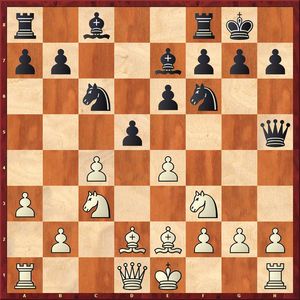
“This is one of the most direct plans” (B.Gelfand).
Unlike Inarkiev, Gelfand avoids the hedgehog structure and strives at breaking up the center immediately.
11.exd5 exd5 12.cxd5 Nxd5 13.Nd4 Qe5
13...Nxc3 14.Nxc6 bxc6 15.Bxc3 Qh4 would be a more principled approach, as in Bacrot – Ragger, Haguenau 2013, since after a simple 16.0-0 Black’s position is rather unpleasant.
14.Nxc6 bxc6 15.0-0 Be6 16.Re1
The game Huzman – Timofeev, Novi Sad 2016 saw 16.Bf3 Rfd8 17.Re1 Nxc3, and White could have achieved an edge by 18.Qc2! Qc5 19.Bxc3 Bf6 20.Be4.
16...Rad8 17.Bf3 Qb8 18.Qc2
“An ambitious move” (B.Gelfand)
“I was not especially worried about my position. Right now I have only my a1-rook out of play yet, but otherwise my pieces are deployed actively.
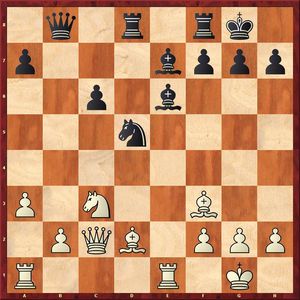
18...Nf4
“This moves gives rise to some sort of a semi-forced play.” (B.Gelfand).
The alternative is 18...Bf6, but then 19.Ne4!? Qxb2 20.Nxf6+ Qxf6 21.Qxc6 leads to a sustained edge for White.
19.Be4
"Is it the move to blame?" (E.Inarkiev).
"Yes, but it's not clear what White is supposed to do." (B.Gelfand).
19.Be3 runs into an unpleasant 19…Nd3 20.Re2 Bf6 (rather than 20...Bb3? 21.Bxa7!).
The best move, perhaps, is 19.Bxc6 Nd3 20.Nd5! (20.Reb1?? Bb3!, and the queen is trapped) 20...Bxd5 21.Rxe7 Qd6 22.Bxd5 Qxe7 23.Qxd3 Qe5 24.Bxf7+ Kxf7 with a likely draw.
19...Bg5! 20.Be3 f5 21.Bxc6 Bb3 22.Qb1 Rd6
“"22...Bf6 might be also an option, just playing for compensation, but the text poses very serious problems as well. All of a sudden, White finds himself in the woods” (B.Gelfand).
“It goes without saying that Black is compensated for the missing pawn, but it may evaporate any moment” (E.Inarkiev).
23.Bf3 Rh6
“Black’s moves are very committal. There must be some blow available, otherwise the compensation is likely to disappear” (E.Inarkiev).
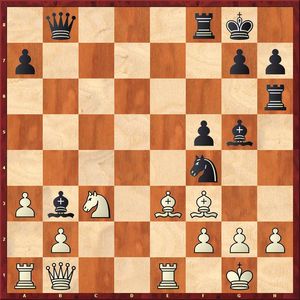
24.Bd1!
This is an only move in Gelfand’s opinion. On the other hand, Inarkiev thought 24.g3 possible either. “This is an interesting position, but I do not think White is losing, honestly speaking. On the other hand, Black’s initiative is obvious here; therefore, there is no point going for it if there is a normal continuation available instead“ (E. Inarkiev).
The engine is less optimistic, claiming that 24…Nh3+ 25.Kg2 Bxe3 26.Rxe3 f4 27.Re2 Ng5! or 27.Rd3 Nxf2! 28.Kxf2 fxg3+ 29.hxg3 Rh2+ is winning for Black.
24...Bc4
Inarkiev sshared he was also contemplating two other moves in this position: 24...Ne2+ and 24...Nxg2. The grandmaster pointed out a very nice line for the former: 24...Ne2+ 25.Nxe2? Qxh2+ 26.Kf1 Bc4 27.f4 Bd5! – the white king is completely boxed in and there is no avoiding a checkmate.
Therefore, in lieu of 25.Nxe2? it is essential that White reacts with 25.Kf1. The grandmasters went on to delve into 25...Bxd1 26.Qxd1 (losing is both 26.Nxe2 Bxe2+ 27.Rxe2 f4, as well as 26.Bxg5 Nxc3 27.bxc3 Qxh2 28.Qa2+ Kh8 29.Raxd1 Qh1+ 30.Ke2 Qh5+ 31.Kd3 Qxg5) 26...Nxc3 27.bxc3 Qxh2 28.Qd5+ Kh8 29.Bd4! (Worse is 29.Bxg5 Qh1+ 30.Ke2 Qh5+ 31.Kd2 Qxg5+ 32.Kc2) “Bishops should not be traded. The king will land on d3 and be safe and sound there. If Black’s attack does not hit the mark, it will backfire soon. Perhaps, Black’s position is OK, but so is White’s” (E.Inarkiev).
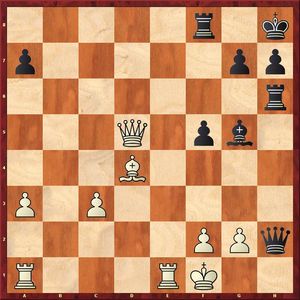
Nevertheless, after 29...Bf6 30.Rab1 Bxd4 31.cxd4 Rg6 Black’s chances are somewhat higher, I should say.
Another continuation is 24...Nxg2 25.Bxb3+ Kh8 26.Bxg5 (bad is 26.Kxg2? Qxh2+ 27.Kf1 f4 28.Bxf4 Qxf4, and Black is winning) 26...Qxh2+ 27.Kf1.
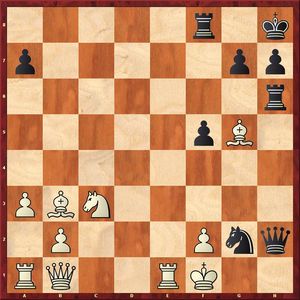
Extremely strong here is 27…Qh3! 28.Ke2 Re8+ 29.Kd2 Rd6+ 30.Bd5 Nxe1, upon which White should rather take the e1-knight, sacrificing his queen. There appears a double-edged position with three minor pieces for the queen. Although the gaming initiative is with Black, there is a lot of fight ahead.
Objectively stronger is 24...Bxd1! 25.Qxd1 Nxg2 26.Qd5+ (losing is 26.Bxg5 Qxh2+ 27.Kf1 Qh1+ 28.Ke2 Re6+ 29.Be3 Qh5+ 30.Kf1 Qh3 or 26.Kxg2 Qxh2+ 27.Kf1 Qh3+ 28.Ke2 Qg4+ 29.Kd2 Rd8+) 26...Kh8
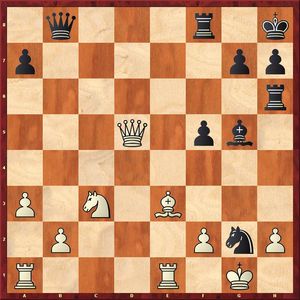
27.Bxg5! B.Gelfand admitted that it was this move that confused him as he could not find any decisive continuation for Black. Indeed, other continuations are not so strong: 27.Qxg2 Bxe3 28.Rxe3 f4 29.Rh3 f3 30.Qg3 (too bad is 30.Rxf3 Rxf3 31.Qxf3 Qxh2+ 32.Kf1 Qh1+ 33.Ke2 Re6+!) 30...Rxh3 31.Qxh3 Qxb2.
After 27.Bxg5! to Black's advantage is 27...Qxh2+ 28.Kf1 Qh1+ 29.Ke2 Re8+ 30.Be3 (30.Kd3? Nxe1+)
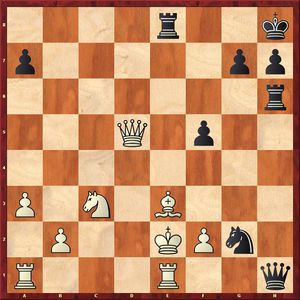
30...Qh2!!
A move like this does not lend itself to easy finding even in close proximity, let alone from afar. 31.Qd7 Rxe3+ 32.fxe3 Nh4+ 33.Kd3 Rd6+ 34.Qxd6 Qxd6+ 35.Kc2 Nf3 36.Red1 Qb6. Although Black’s chances are higher, the fight is far from over yet.
25.Bxf4! Bxf4 26.h3
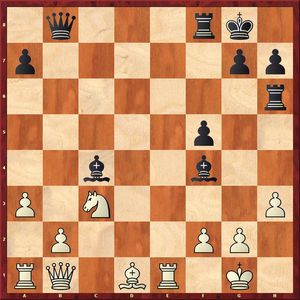
26…Bh2+
“I have somehow lost the thread of the game to find myself in a very unpleasant position” (B.Gelfand).
The grandmasters came to the conclusion Black should have forced a draw after something like 26...Bd2 27.Re7 Qd6 28.Rxa7 Re6 29.Bf3 Rfe8 30.Ra8 Rxa8 31.Bxa8 Re1+ 32.Qxe1 Bxe1 33.Rxe1.
27.Kh1 Be5 28.Qc2 Rb6?
This is a very underwhelming decision as Black’s pieces become subjects to tempo attacks. A dynamic equality is maintained by 28...Kh8 29.Bf3 Bd4.
29.Na4 Rc6 30.Bf3 Rcc8 31.Rad1! Kh8
31...Bb3 fails to 32.Qxb3+! Qxb3 33.Bd5+.
32.b4 Bd6 33.Rd4 Bb5
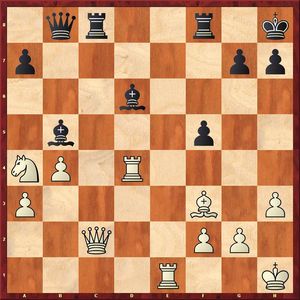
34.Qd2?
“I wanted to win as comfortably as possible and got carried away with it” (E.Inarkiev).
In case of the natural 34.Nc5, the Russian grandmaster was unsure about 34... Qb6, to which Gelfand offered 35.Rd5.
“Indeed, the impression is such that any play is about to exhaust in just a couple of moves...” (E.Inarkiev).
“Black’s position is just too grim” (B.Gelfand).
Let us add that if White was unwilling to have his knight pinned, he could have opted for 34.Qd1.
34...Be5! 35.Rxe5
This is forced because after 35.Rd5? Bf4 36.Qd1 Rc1! White is losing.
35...Qxe5 36.Nc5
“White’s position was so good that even an exchange sacrifice was not enough to go down” (E.Inarkiev).
36...Rfe8 37.a4 Qe1+ 38.Qxe1 Rxe1+ 39.Kh2 Be8 40.Bb7 Rb8 41.Bf3
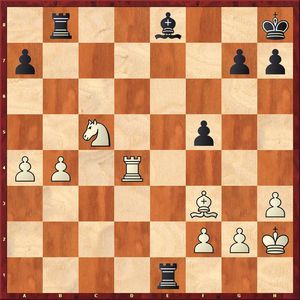
41…g6?!
“41...Re7 was perhaps more precise” (B.Gelfand).
“The question really boils down to whether or not the white pieces are dislodged from their active positions. And what is the idea of the move anyway?” (E.Inarkiev).
“After 42.b5 Rc8 43.Nb7 Black can parry with 43...Rd7!, preventing the white rook from penetrating the sixth rank” (B.Gelfand).
42.b5 Re7 43.Rd6 Kg7
“I thought it would be just a transposition, but I am not in time now: 43...Rc8 44.Nb7!, and the rook infiltrated to a6” (B.Gelfand).
44.h4 Rc8 45.Ne6+ Kg8 46.Ra6 Rc4
“This is a complex position, but should be tenable. I see the computer evaluates it in Black's favor, but any position up an exchange would be evaluated similarly, even if it is a dead draw” (E.Inarkiev).
Ernesto offered a sharp 46...Rb8!? with an idea to trade rooks on b6. Now 47.Rd6 runs into 47...Rd7; therefore, better is 47.Bd5 Bf7, and the fight continues (but not 47…Rb6? 48.Nc7+ and White is winning).
47.h5 gxh5
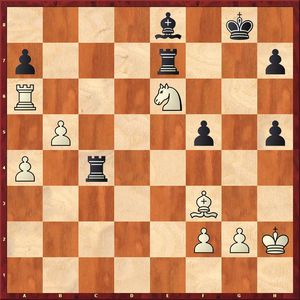
At this moment, with no more than two minutes on clocks of both opponents, Boris Gelfand offered a draw that was accepted by Ernesto Inarkiev.
"There is no big risk for anyone, but after what has happened in the game it felt like enough already" (B. Gelfand).
“With Black up an exchange, declining a draw would be somewhat weird. Should Black want to trade all pieces off the board, I do not think he will have any problems achieving this. Another thing is, if he is willing to persist, he needs to take risks, and White will have a dangerous counterplay with a4-a5 and b5-b6.
Well, Boris was unwilling to sacrifice, and then I lost an exchange in just one move...” (E.Inarkiev).











